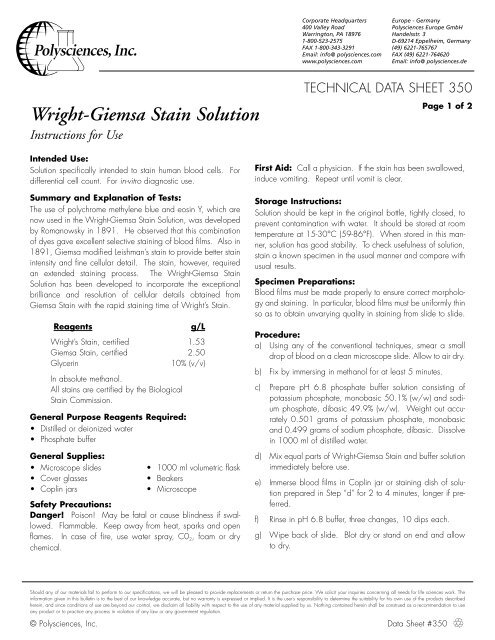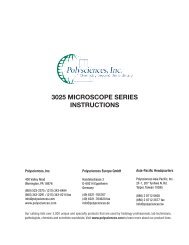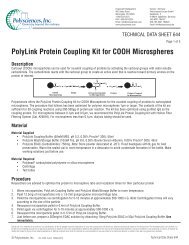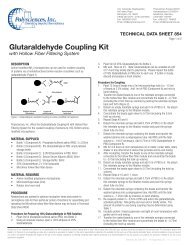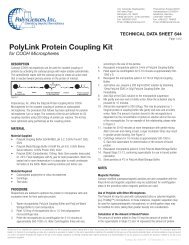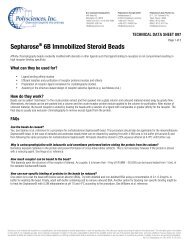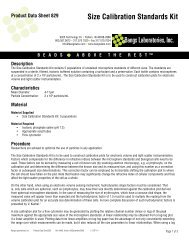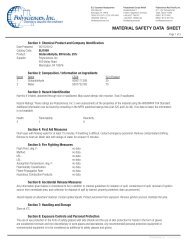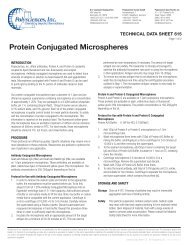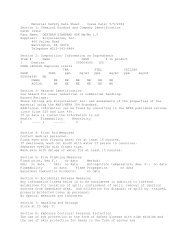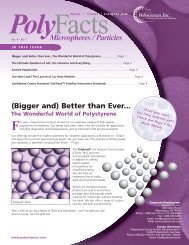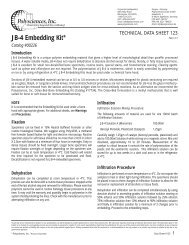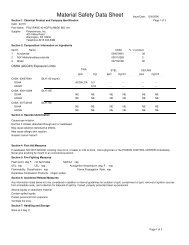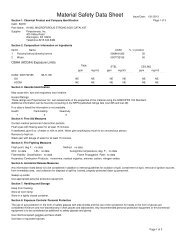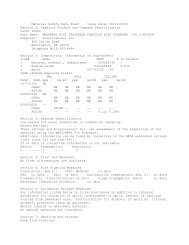Data Sheet #350: Wright-Giemsa Stain Solution - Polysciences, Inc.
Data Sheet #350: Wright-Giemsa Stain Solution - Polysciences, Inc.
Data Sheet #350: Wright-Giemsa Stain Solution - Polysciences, Inc.
You also want an ePaper? Increase the reach of your titles
YUMPU automatically turns print PDFs into web optimized ePapers that Google loves.
Corporate Headquarters<br />
400 Valley Road<br />
Warrington, PA 18976<br />
1-800-523-2575<br />
FAX 1-800-343-3291<br />
Email: info@ polysciences.com<br />
www.polysciences.com<br />
Europe - Germany<br />
<strong>Polysciences</strong> Europe GmbH<br />
Handelsstr. 3<br />
D-69214 Eppelheim, Germany<br />
(49) 6221-765767<br />
FAX (49) 6221-764620<br />
Email: info@ polysciences.de<br />
<strong>Wright</strong>-<strong>Giemsa</strong> <strong>Stain</strong> <strong>Solution</strong><br />
Instructions for Use<br />
TECHNICAL DATA SHEET 350<br />
Page 1 of 2<br />
Intended Use:<br />
<strong>Solution</strong> specifically intended to stain human blood cells. For<br />
differential cell count. For in-vitro diagnostic use.<br />
Summary and Explanation of Tests:<br />
The use of polychrome methylene blue and eosin Y, which are<br />
now used in the <strong>Wright</strong>-<strong>Giemsa</strong> <strong>Stain</strong> <strong>Solution</strong>, was developed<br />
by Romanowsky in 1891. He observed that this combination<br />
of dyes gave excellent selective staining of blood films. Also in<br />
1891, <strong>Giemsa</strong> modified Leishman’s stain to provide better stain<br />
intensity and fine cellular detail. The stain, however, required<br />
an extended staining process. The <strong>Wright</strong>-<strong>Giemsa</strong> <strong>Stain</strong><br />
<strong>Solution</strong> has been developed to incorporate the exceptional<br />
brilliance and resolution of cellular details obtained from<br />
<strong>Giemsa</strong> <strong>Stain</strong> with the rapid staining time of <strong>Wright</strong>’s <strong>Stain</strong>.<br />
Reagents<br />
g/L<br />
<strong>Wright</strong>’s <strong>Stain</strong>, certified 1.53<br />
<strong>Giemsa</strong> <strong>Stain</strong>, certified 2.50<br />
Glycerin<br />
10% (v/v)<br />
In absolute methanol.<br />
All stains are certified by the Biological<br />
<strong>Stain</strong> Commission.<br />
General Purpose Reagents Required:<br />
• Distilled or deionized water<br />
• Phosphate buffer<br />
General Supplies:<br />
• Microscope slides<br />
• Cover glasses<br />
• Coplin jars<br />
• 1000 ml volumetric flask<br />
• Beakers<br />
• Microscope<br />
Safety Precautions:<br />
Danger! Poison! May be fatal or cause blindness if swallowed.<br />
Flammable. Keep away from heat, sparks and open<br />
flames. In case of fire, use water spray, C0 2 , foam or dry<br />
chemical.<br />
First Aid: Call a physician. If the stain has been swallowed,<br />
induce vomiting. Repeat until vomit is clear.<br />
Storage Instructions:<br />
<strong>Solution</strong> should be kept in the original bottle, tightly closed, to<br />
prevent contamination with water. It should be stored at room<br />
temperature at 15-30°C (59-86°F). When stored in this manner,<br />
solution has good stability. To check usefulness of solution,<br />
stain a known specimen in the usual manner and compare with<br />
usual results.<br />
Specimen Preparations:<br />
Blood films must be made properly to ensure correct morphology<br />
and staining. In particular, blood films must be uniformly thin<br />
so as to obtain unvarying quality in staining from slide to slide.<br />
Procedure:<br />
a) Using any of the conventional techniques, smear a small<br />
drop of blood on a clean microscope slide. Allow to air dry.<br />
b) Fix by immersing in methanol for at least 5 minutes.<br />
c) Prepare pH 6.8 phosphate buffer solution consisting of<br />
potassium phosphate, monobasic 50.1% (w/w) and sodium<br />
phosphate, dibasic 49.9% (w/w). Weight out accurately<br />
0.501 grams of potassium phosphate, monobasic<br />
and 0.499 grams of sodium phosphate, dibasic. Dissolve<br />
in 1000 ml of distilled water.<br />
d) Mix equal parts of <strong>Wright</strong>-<strong>Giemsa</strong> <strong>Stain</strong> and buffer solution<br />
immediately before use.<br />
e) Immerse blood films in Coplin jar or staining dish of solution<br />
prepared in Step “d” for 2 to 4 minutes, longer if preferred.<br />
f) Rinse in pH 6.8 buffer, three changes, 10 dips each.<br />
g) Wipe back of slide. Blot dry or stand on end and allow<br />
to dry.<br />
Should any of our materials fail to perform to our specifications, we will be pleased to provide replacements or return the purchase price. We solicit your inquiries concerning all needs for life sciences work. The<br />
information given in this bulletin is to the best of our knowledge accurate, but no warranty is expressed or implied. It is the user’s responsibility to determine the suitability for his own use of the products described<br />
herein, and since conditions of use are beyond our control, we disclaim all liability with respect to the use of any material supplied by us. Nothing contained herein shall be construed as a recommendation to use<br />
any product or to practice any process in violation of any law or any government regulation.<br />
© <strong>Polysciences</strong>, <strong>Inc</strong>. <strong>Data</strong> <strong>Sheet</strong> <strong>#350</strong> 1
TECHNICAL DATA SHEET 350<br />
Page 2 of 2<br />
h) Examine smear by microscope, with or without coverslipping.<br />
If using a coverslip, use the least amount of mounting<br />
medium and a No. 1 thickness coverglass if the blood<br />
is spread on the slide. If the blood is spread on a coverglass,<br />
the thickness should be No. 1 1 /2.<br />
i) Discard the stain and the buffer rinses after each use.<br />
Results:<br />
• Erythrocytes appear yellowish-red to tawny.<br />
• Polymorphonuclear neutrophils’ cytoplasm appears pale<br />
pink to tan; the granules, lilac; the nuclei, reddish-purple.<br />
• Eosinophils’ granules appear red-orange; the nuclei,<br />
reddish-purple.<br />
• Basiphils’ granules appear purple to dark bluish-purple;<br />
the nuclei, reddish-purple.<br />
• Lymphocytes’ cytoplasm appears sky blue; the nuclei, red<br />
dish-purple.<br />
• Platelets appear violet to purple.<br />
Limitations:<br />
The information obtained from the blood smear is dependent on<br />
the method of specimen collection, the preparation of the film,<br />
the drying, the fixation and the final staining of the smear. To<br />
this end, slides should be free of all dirt and oily film. Care<br />
should be taken in the staining and washing, as it can result in<br />
a precipitate, the wrong colors or excessive coloring. This<br />
excessive staining can also be due to thick smears.<br />
Ordering Information:<br />
Cat. # Description Size<br />
08711 <strong>Wright</strong>-<strong>Giemsa</strong> <strong>Stain</strong> 470ml<br />
To Order:<br />
In The U.S. Call: 1-800-523-2575 • 215-343-6484<br />
In The U.S. FAX: 1-800-343-3291 • 215-343-0214<br />
In Germany Call: (49) 6221-765767<br />
In Germany FAX: (49) 6221-764620<br />
Order online anytime at www.polysciences.com<br />
References:<br />
1) Romanowsky, D.L., St. Petersburg Med. Wshr. 16,<br />
pp. 297-302, 307-315 (1891).<br />
2) Lillie, R.O., Biological <strong>Stain</strong>s, 8th Edition, Williams<br />
& Wilkins Co., Baltimore, MD, 1969, pp. 350-357.<br />
3) Ibid., pp. 355-360.<br />
Should any of our materials fail to perform to our specifications, we will be pleased to provide replacements or return the purchase price. We solicit your inquiries concerning all needs for life sciences work. The<br />
information given in this bulletin is to the best of our knowledge accurate, but no warranty is expressed or implied. It is the user’s responsibility to determine the suitability for his own use of the products described<br />
herein, and since conditions of use are beyond our control, we disclaim all liability with respect to the use of any material supplied by us. Nothing contained herein shall be construed as a recommendation to use<br />
any product or to practice any process in violation of any law or any government regulation.<br />
© <strong>Polysciences</strong>, <strong>Inc</strong>. <strong>Data</strong> <strong>Sheet</strong> <strong>#350</strong> 1


